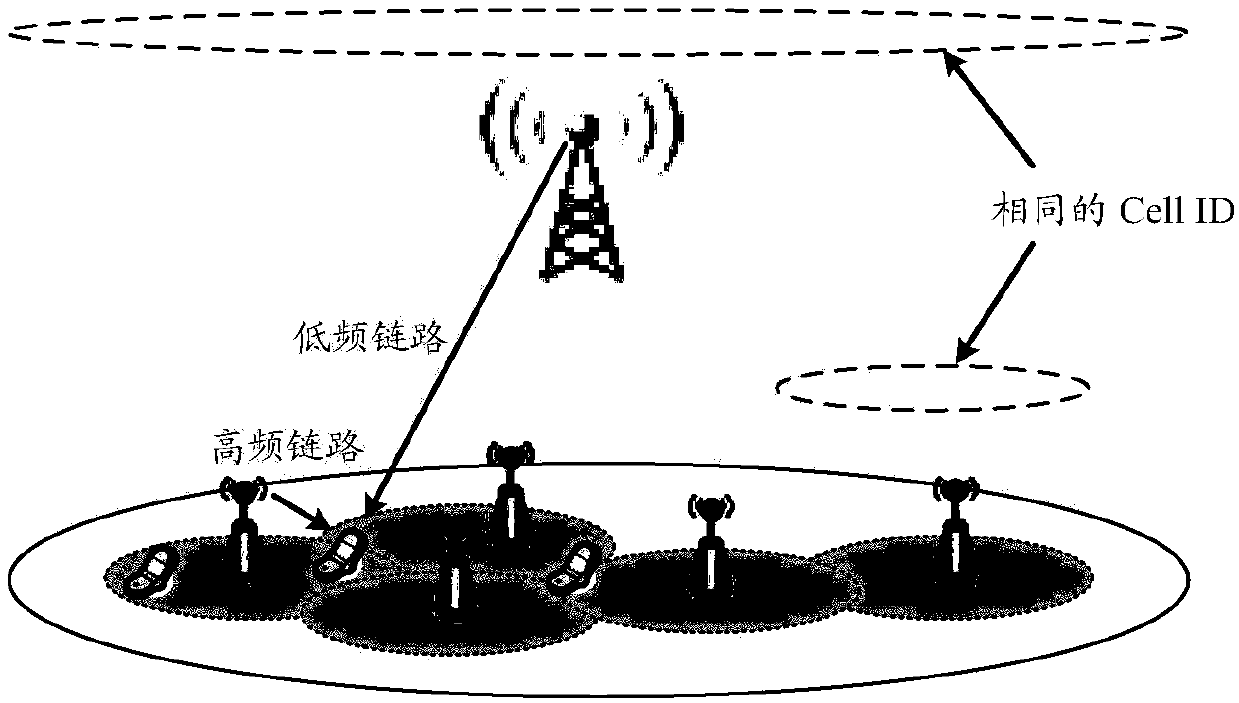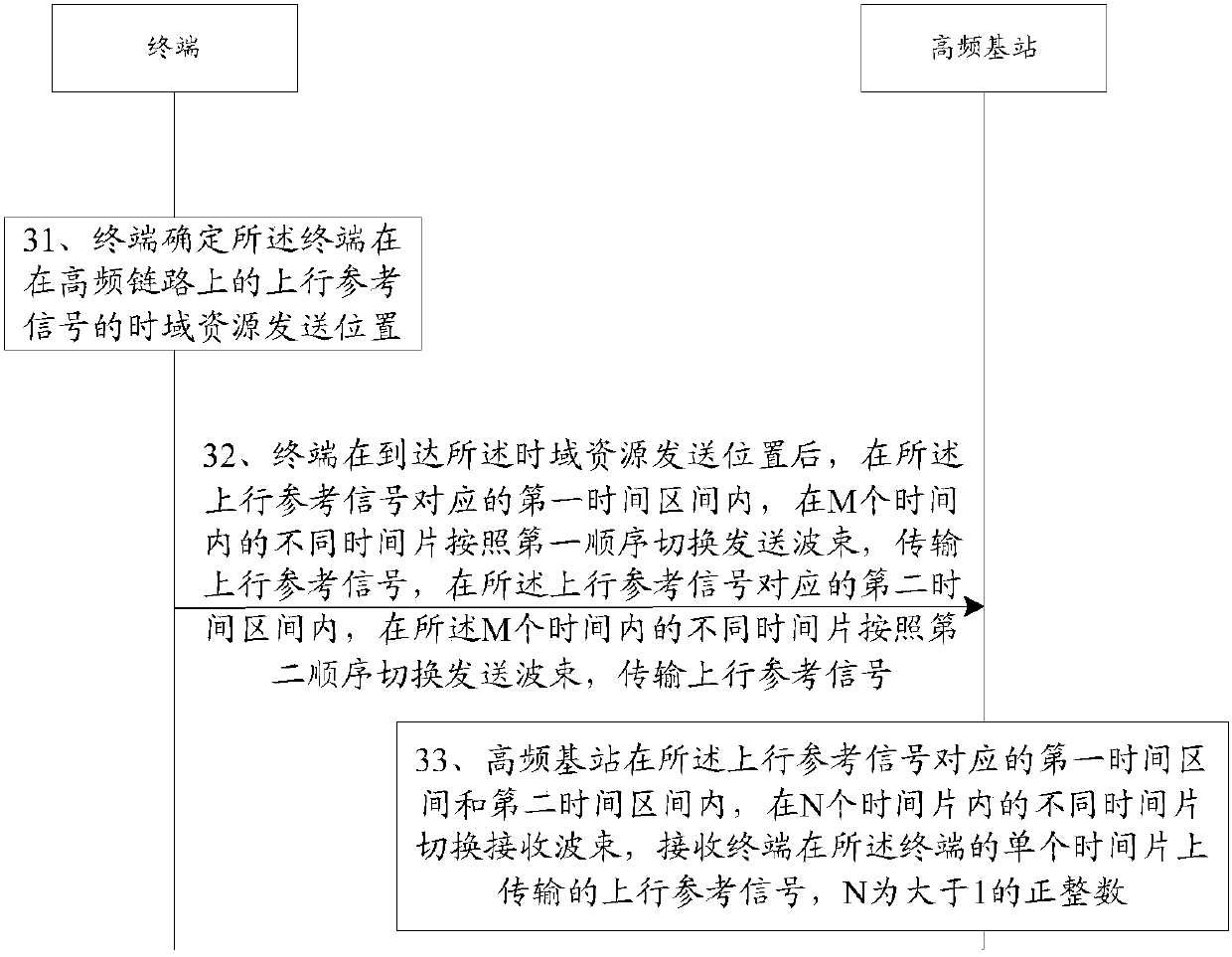Uplink reference signal transmission method and device
A reference signal and transmission method technology, applied in the field of uplink reference signal transmission methods and devices, can solve the problems of lack of beam detection, partial interference of reference measurement signal data, delay difference between low frequency macro stations and high frequency micro stations, etc. Improve transmission efficiency and accuracy, overcome the lack of beam detection, and reduce system overhead
- Summary
- Abstract
- Description
- Claims
- Application Information
AI Technical Summary
Problems solved by technology
Method used
Image
Examples
Embodiment 1
[0139] Such as Figure 10 As shown, embodiment one provides a kind of application figure 2 The shown mixed network of high-frequency micro-station and low-frequency macro-station or Figure 9 The frame structure in the communication system in which multiple high-frequency base stations are mixed networking is shown. Wherein, the high-frequency base station in the hybrid networking scenario of multiple high-frequency base stations may be a high-frequency macro station or a high-frequency micro station.
[0140] Figure 10 10 milliseconds are used as the frame length of a wireless frame; the wireless frame is composed of 10 wireless subframes with a frame length of 1 millisecond; a wireless subframe is divided into 8 subframes with a length of 0.125 milliseconds A time slot (time slot); wherein, each time slot consists of Q symbols, and the symbols may be single-carrier symbols or multi-carrier symbols, such as OFDM symbols. A typical Q value can be set to 7n, where n is a ...
Embodiment 2
[0143] Such as Figure 11A with Figure 11B As shown, the second embodiment provides another application figure 2 The shown mixed network of high-frequency micro-station and low-frequency macro-station or Figure 9 The frame structure in the communication system in which multiple high-frequency base stations are mixed networking is shown. Wherein, the high-frequency base station in the hybrid networking scenario of multiple high-frequency base stations may be a high-frequency micro-station or a high-frequency macro-station.
[0144] Such as Figure 11A As shown, the difference from Embodiment 1 is that since the uplink reference signal is not continuous in the time domain resource, the NoMP intervals for transmitting the uplink reference signal are also distributed, and the NoMP interval is divided into several NoMP segments.
[0145] Figure 11B 10 milliseconds are used as the frame length of a wireless frame; the wireless frame is composed of 10 wireless subframes with...
Embodiment 3
[0148] Based on the frame structures given in Embodiment 1 and Embodiment 2, Embodiment 3 provides a method for transmitting an uplink synchronization reference signal, and the method is applied to figure 2 The network deployment scenario shown, such as Figure 12 As shown, the specific steps include:
[0149] Step 121: The terminal completes synchronization with the low-frequency macro station based on the low-frequency link, and obtains the system clock on the network side and the uplink TA of the terminal on the low-frequency link.
[0150] Step 122: the terminal determines the time domain resource sending position of the uplink synchronization reference signal on the high frequency link.
[0151] The method of determining the sending position of time domain resources can use the system clock obtained by the low frequency link and / or the uplink TA value obtained by the terminal on the low frequency link, and use the starting point of a time slot of the low frequency link ...
PUM
 Login to View More
Login to View More Abstract
Description
Claims
Application Information
 Login to View More
Login to View More - R&D
- Intellectual Property
- Life Sciences
- Materials
- Tech Scout
- Unparalleled Data Quality
- Higher Quality Content
- 60% Fewer Hallucinations
Browse by: Latest US Patents, China's latest patents, Technical Efficacy Thesaurus, Application Domain, Technology Topic, Popular Technical Reports.
© 2025 PatSnap. All rights reserved.Legal|Privacy policy|Modern Slavery Act Transparency Statement|Sitemap|About US| Contact US: help@patsnap.com



